Search results for: 'form'
-
 Protogeld in Form einer Pfeilspitze
Protogeld in Form einer PfeilspitzeVormünzliche Geldform aus dem 7. - 6. Jh. v. Chr., geprägt in Istros, sehr guter Zustand.
Price: on request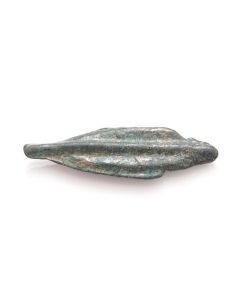 Protogeld in Form einer Pfeilspitze
Protogeld in Form einer PfeilspitzeVormünzliche Geldform aus dem 7. - 6. Jh. v. Chr., geprägt in Istros, sehr guter Zustand.
Price: on request Protogeld in Form einer Pfeilspitze
Protogeld in Form einer PfeilspitzeVormünzliche Geldform aus dem 7. - 6. Jh. v. Chr., geprägt in Istros, perfekte Erhaltung. Länge 44 mm.
Price: on request Protogeld in Form einer Pfeilspitze
Protogeld in Form einer PfeilspitzeVormünzliche Geldform aus dem 7. - 6. Jh. v. Chr., geprägt in Istros, guter Erhaltungszustand. Länge 32 mm.
Price: on request Seltenes skythisches Protogeld in Pfeilform
Seltenes skythisches Protogeld in PfeilformVormünzliche Geldform aus dem 7. - 6. Jh. v. Chr., Schwarzmeerregion, sehr guter Zustand.
Price: on request Seltenes skythisches Protogeld in Pfeilform
Seltenes skythisches Protogeld in PfeilformVormünzliche Geldform aus dem 7. - 6. Jh. v. Chr., Schwarzmeerregion, sehr guter Zustand.
Price: on request Hochgradig seltenes skythisches Protogeld in Pfeilform
Hochgradig seltenes skythisches Protogeld in Pfeilform7. - 6. Jh. v. Chr., Schwarzmeerregion, sehr guter Zustand
Price: on request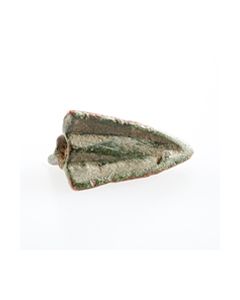 Schön geformte skythische Pfeilspitze
Schön geformte skythische Pfeilspitzeantike Bronzepfeilspitze. Dreiflüglig. Exzellente Erhaltung mit schöner Patina. Typisch für skythische Völker ab ca. 700 v.Chr.
Price: on request Schön geformte skythische Pfeilspitze
Schön geformte skythische Pfeilspitzeantike Bronzepfeilspitze. Dreiflüglig. Exzellente Erhaltung mit schöner Patina. Typisch für skythische Völker ab ca. 700 v.Chr.
Price: on request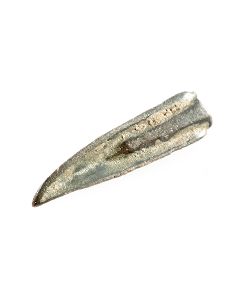 Schön geformte skythische Pfeilspitze
Schön geformte skythische Pfeilspitzeantike Bronzepfeilspitze. Museale Erhaltung mit schöner Patina und Bodenablagerungen
Price: on request Clay rattle shaped as a bird from the Lusatian culture
Clay rattle shaped as a bird from the Lusatian cultureRassel in Form eines Hauses. Aus dem Übergang der Späten Bronzezeit zur Frühen Eisenzeit Nordmittel-Europas. 1300 bis 500 v. Chr.
Price: on request Seltene Hausurne der Lausitzer-Kultur
Seltene Hausurne der Lausitzer-KulturGroßes Urnengefäß in Form eines Hauses. Aus dem Übergang der Späten Bronzezeit zur Frühen Eisenzeit Nordmittel-Europas. 1300 bis 500 v. Chr.
Price: on request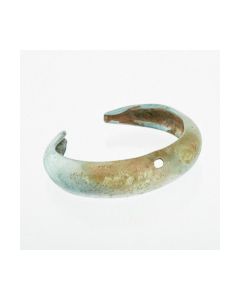 Iron Age bronze bracelet
Iron Age bronze braceletElegante, ovale Form mit C-förmigem Profil. Seltenes Belegstück für einen Schmuckreif aus der Anfängen der europäischen Eisenzeit.
Price: on request Daunian jug with high handle
Daunian jug with high handleItalic pottery in the subgeometric style. Made around 500 BC in Apulia. Handled vessels of this type are an guiding form in Apulian archaeology.
Price: on request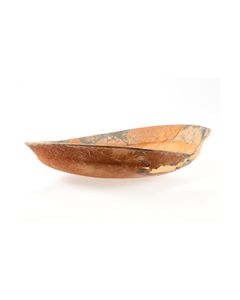 Museale Bronzeschale aus dem 1. Jahrtausend v. Chr.
Museale Bronzeschale aus dem 1. Jahrtausend v. Chr.Begehrtes Statussymbol jener Zeit, gerne in Keramik imitiert. Seltenes, großes Stück. 175mm Durchmesser, mit schöner Patina.
Price: on request Large decorated violin bow fibula
Large decorated violin bow fibulaImpressive piece of jewellery because of its size and decoration. From Central Europe, made during Late Bronze Age or Early Iron Age.
Price: on request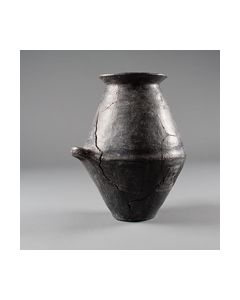 Funerary urn from the Villanova culture - found in Chiusi, Italy
Funerary urn from the Villanova culture - found in Chiusi, ItalyKeramik aus dem 9. Jh. v. Chr., unmittelbar vor der etruskischen Besiedelung. Ritzdekor aus Swastika und anderen geometrischen Elementen. Gefunden in Chiusi, Norditalien.
Price: on request Large Villanova culture krater
Large Villanova culture kraterVery large, impressively preserved object. From an old Dutch private collection.
Price: on request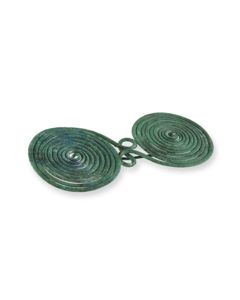 Magnificent spectacle brooch from Greece
Magnificent spectacle brooch from GreeceThe very large bronze brooch was made between the 9th and 6th century BC. It is formed by a single piece of wire. With an old expertise from Nefer Gallery.
€4,700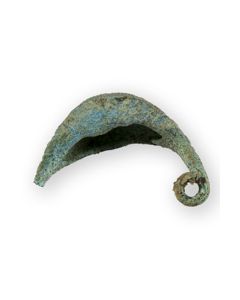 Early Etruscan sanguisuga fibula
Early Etruscan sanguisuga fibulaThe early Etruscan bronze brooch is characterized by its artistically decorated bow. A find from northern Italy.
€180 Early Etruscan sanguisuga fibula
Early Etruscan sanguisuga fibulaThe early Etruscan bronze brooch is characterized by its artistically decorated bow. From the collection of Professor Alder-Kissling.
Price: on request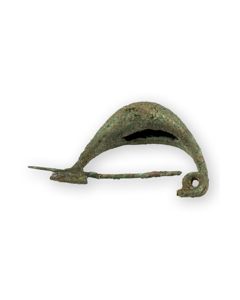 Early Etruscan sanguisuga fibula
Early Etruscan sanguisuga fibulaThe early Etruscan bronze brooch is characterized by its artistically decorated bow. A find from northern Italy.
€325 Early Etruscan sanguisuga fibula
Early Etruscan sanguisuga fibulaThe early Etruscan bronze brooch is characterized by its artistically decorated bow. A find from northern Italy.
€420 Early Etruscan sanguisuga fibula
Early Etruscan sanguisuga fibulaThe early Etruscan bronze brooch is characterized by its artistically decorated bow. A find from northern Italy.
€320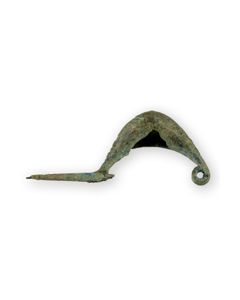 Early Etruscan sanguisuga fibula
Early Etruscan sanguisuga fibulaThe early Etruscan bronze brooch is characterized by its artistically decorated bow. A find from northern Italy.
€310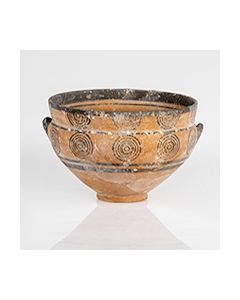 Large cypriot bowl, ex Sotheby's
Large cypriot bowl, ex Sotheby'sDating to the early cypro-archaic period, so-called black-on-red ware II. From an old German private collection, acquired 1970 at Sotheby's. Coming with an ArtLoss certificate.
Price: on request Early Etruscan sanguisuga fibula
Early Etruscan sanguisuga fibulaThe early Etruscan bronze brooch is characterized by its artistically decorated bow. A find from northern Italy.
€350 Villanovan fibula from the Hattatt collection
Villanovan fibula from the Hattatt collectionBronze brooch of the Italic Iron Age. The piece is published in the standard work "Brooches of Antiquity".
Price: on request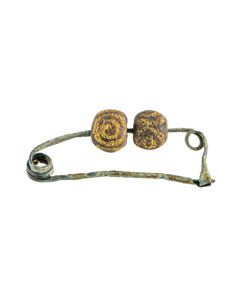 Early Italic brooch decorated with beads
Early Italic brooch decorated with beadsThere rare brooch type from northern Italy is based on predecessors from Greece. The piece is from the famous Richard Hattatt collection and is published in two of his works.
Price: on request Gesichtsurne der Lausitzer-Kultur
Gesichtsurne der Lausitzer-KulturSeltenes anthropomorphes Gefäß, 1300 bis 500 v. Chr. Eindrucksvolle 24cm hoch. Komplett erhalten mit Deckel. Aus der Sammlung Dr. Rüssmann.
Price: on request Gesichtsurne mit Deckel, Lausitzer Kultur
Gesichtsurne mit Deckel, Lausitzer KulturÄußerst seltener und beliebter Gefäßtyp der Lausitzer Kultur. Etwa 1300 bis 500 v. Chr., Übergang zwischen Bronze- und Eisenzeit in Europa. Komplett erhalten, inklusive Deckel.
Price: on request

